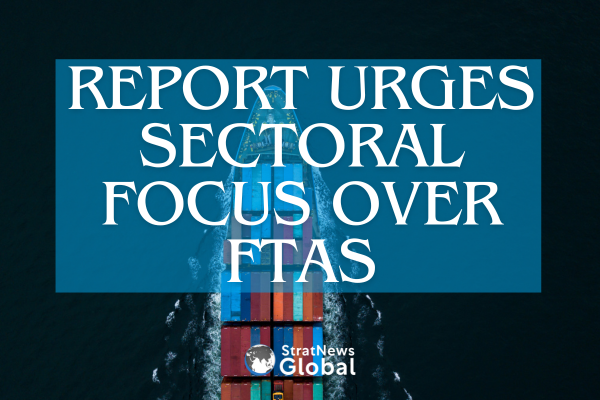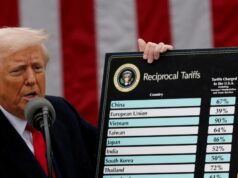Global Trade Research Institute headed by former Trade Service officer Ajay Srivastava, has published a report on India’s Free Trade Agreements. It says there is a major focus away from East to West, with the government targeting the major economies of the world US, UK, EU, Switzerland, Norway and Russia. This means by the end of 2024, India may have completed or nearing completion of an FTA with all major economies except China. With China we have a small 3000 tariff line preferential trade agreement.
India currently has comprehensive Free Trade Agreements (FTAs) with 22 countries. It is now negotiating new FTAs with 49 countries. Once these FTAs are signed and implemented India will have FTAs with 71 countries covering $337 billion or 74.7% of India’s exports. In addition, we also have small coverage PTAs with 26 more countries not covered in above categories. Including these, India will have preferential relationship with 96 countries covering $399 billion or 88.4% of India’s exports.
In all new FTAs, India is negotiating many new non-trade areas such as Sustainable Development, Digital, IPR, Labour, Gender, MSME Government Procurement, Competition, etc. India is reluctantly changing its earlier approach to focus only on traditional market access subjects like merchandise and services trade to also including new issues. Most new issues restrict policy space for domestic regulations by forcing adoption of developed country regulations.
The report notes that a diverse range of countries, from large economies to smaller ones like Oman and Peru, are seeking FTAs with India, primarily due to India’s high import duties and rapidly growing market. But the key FTAs with ASEAN, South Korea, and Japan have shown a significant increase in trade deficits and a lower growth rate in exports compared to imports.
The analysis of India’s three key Free Trade Agreements (FTAs) with ASEAN, South Korea, and Japan, signed in 2010-2011, reveals two main trends in trade performance.
While India’s merchandise trade deficit with these partners increased significantly more than its global trade deficit. Specifically, the deficits grew by 302.9% with ASEAN, 164.1% with South Korea, and 138.2% with Japan, compared to a 81.2% increase in the global deficit.
This comparison is based on data from the pre-FTA period (2007-09) and recent trade data (2020-22).
Second, India’s exports to these FTA partners have increased at a lower rate than its imports. For instance, with ASEAN, exports grew by 123.9% and imports by 175.7%; with Japan, exports grew by 56.4% and imports by 98.5%; and with South Korea, exports increased by 89.1% and imports by 127.3%.
The reasons behind India’s weaker export performance include higher tariffs in India and lower tariffs in its FTA partner countries. Many Indian firms choose not to use the FTA route when import duties are low, as FTA-related compliance costs do not justify the tariff benefits. For example, in the case of India’s FTA partners, many imports occur at zero or low Most Favored Nation (MFN) duties, such as Singapore (0%), Japan (2.4%), Malaysia (3.5%), Vietnam (5.3%), Mauritius (1.1%), UAE (3.5%), and Australia (2.6%). This situation limits the additional market access that FTAs could provide to Indian exporters.
Conversely, India has higher import duties, so eliminating these duties under FTAs gives a price advantage to products from FTA partner countries. Current negotiations might not significantly increase India’s exports due to the low import duties in partner countries, potentially resulting in India importing more post-FTA.
In the case of developed countries, the UK’s duties are 4.1%, Canada’s 3.3%, and the USA’s 2.3%. In contrast, India’s import duties are higher at 12.6%. Also, a substantial share of their imports is already at zero MFN duties, as would be clear from the following details: Canada- 70.8%, Switzerland- 61%, USA- 58.7%, UK- 52%, EU- 51.8 % In contrast, in India only 6.1 % of global imports are undertaken at zero MFN duty.
Let us divide world trade in manufactured goods into two broad groups. (I) Medium- to high-tech goods that account for 70% of world trade, and (II) Labour-intensive goods like shirts and shoes that account for the remaining 30%. Developed countries charge zero or low import duties on most medium- to high-tech goods. And high duties on shirts and shoes manufactured by developing countries.
When a developing country enters into an FTA with a developed country, the developing country gets preferential access for its shirts and shoes in the developed country. In return, it has to remove duty on most products. The developing country gets additional market access in 30% of products. In contrast, the rich nation would get additional market access in 90% plus the value of products (except those kept in the negative list).
Strategies for Better FTA Outcomes
- Create a common exclusion list for merchandise trade.
- Focus on sectoral agreements instead of comprehensive FTAs with small economies.
- Prioritize obtaining real market access on the ground.
- Negotiate new subject areas like environment, labor, and digital trade cautiously to avoid limiting domestic regulatory autonomy.
- Consider the impact of carbon taxes and other regulations like CBAM in FTA negotiations.
It’s crucial to debunk common myths, such as the belief that most world trade happens through FTAs or that FTAs automatically lead to increased exports and lower prices. India’s path forward in FTA negotiations requires strategic planning, adaptability, and a focus on improving the quality of Indian goods for the global market, while safeguarding domestic interest
Thirty eight years in journalism, widely travelled, history buff with a preference for Old Monk Rum. Current interest/focus spans China, Technology and Trade. Recent reads: Steven Colls Directorate S and Alexander Frater's Chasing the Monsoon. Netflix/Prime video junkie. Loves animal videos on Facebook. Reluctant tweeter.





